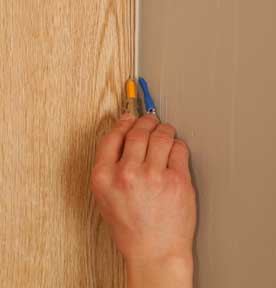Consult your building plans and snap a chalk line to outline the area for the stud wall with pair of lines parallel and 3 1 2 inches apart.
Securing wall paneling how far apart should nails be.
When installing on a framed wall make sure the studs are spaced properly either 16 inches or 24 inches apart.
Both the international residential code irc and usg the manufacturer of sheetrock say that maximum field screw spacing for wall drywall is 16 inches.
Damp proof any exterior walls you re paneling and add backing to reach each corner.
While a partner holds the panel use finishing nails to attach it to the wall.
You can glue them on but it s better to use anchors.
This is a reasonable guide most of the time.
Some builders like to space fasteners tighter than that so they go down to 12 inches.
The field is considered a more stable area.
Use a masonry drill and masonry screws for masonry walls and nails for wood framed walls.
The flush set of the appropriately colored nail head will blend in with the darker seam color of the panel.
Nails should extend one inch into the studs through the furring strips for a good hold.
Drive the nails in at a slight angle to avoid splitting off the panel s tongue.
Use a studfinder to locate the studs and nail into those so your panel is secure.
Measure mark and cut a 2 by 4 to serve as the bottom.
Plywood paneling is anchored into wooden wall studs using colored paneling nails also called finishing nails or brads driven inside the darker seams of the paneling.
For this approach the nail head is covered making it possible to use a greater variety of nail types.
To choose the right sized nail add to that 1 2 inch the thickness of the drywall usually 1 2inch and the thickness of the trim board.
Continue until all walls are covered and all moulding is attached.
Pound the nails in with a hammer and then tap them in flush with a nail set.
When nailing very thin materials into wood a minimum of 1 2 of penetration is necessary.
Space anchors about 8 to 10 inches apart.
Repeat across the length of the top of the wall then move to.
Generally the nails are no longer than 1 inch but if they will be going through drywall increase the nail length to 1 5 8 inches.
For example if you are working with tongue and groove paneling that aligns with the studs in your wall you can nail each panel into the wall right above the tongue.




























